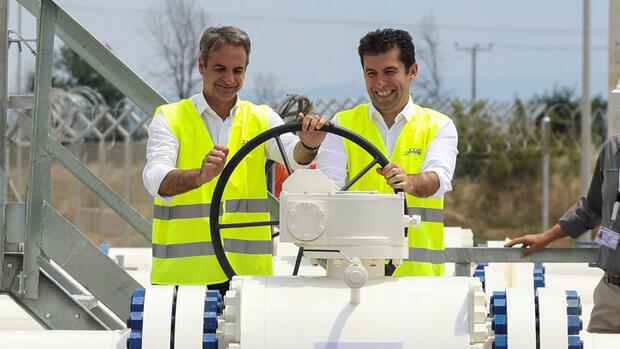Athens Greek Prime Minister Kyriakos Mitsotakis and his Bulgarian counterpart Kyril Petkov join forces to turn the big blue wheel. The gas then flows through the tubes. Regular operation of the Gas Interconnector Greece-Bulgaria (IGB), as the new natural gas pipeline is called, began on Friday afternoon. It will change the energy map of Southeast Europe.
Mitsotakis sees the line as an answer to “Russia’s blackmail”. At the ceremony in Komotini, northern Greece, Petkov said the pipeline would “put an end to the Russian monopoly.” The IGB is the most important link in a pipeline network with which the countries of Southeast Europe want to free themselves from their dependence on the Russian state-owned company Gazprom for gas supplies.
The first plans for the line go back to 2009, long before anyone thought of a crisis in Ukraine. At that time, Greece and Bulgaria signed a first memorandum. In 2011 the joint venture IGB was founded. The Bulgarian state energy holding company BEH EAD holds 50 percent of this, while the Greek gas supplier DEPA and the Italian energy company Edison SpA share the other 50 percent.
The pipeline runs 182 kilometers from Komotini in Greece to Stara Zagora in Bulgaria. The construction costs amounted to around 240 million euros. The EU contributed 45 million euros to the financing.
Top jobs of the day
Find the best jobs now and
be notified by email.
The tube is just in time. Because Russia is now turning on the gas tap. Italy and Slovakia also get less Russian gas, France none at all. Gazprom had previously stopped deliveries to Poland and Denmark, officially for technical reasons. Federal Minister of Economics Robert Habeck considers this justification to be “simply pretended”.
LPG instead of Russian gas
Moscow turned off the gas for the Bulgarians at the end of April. Since then, the country, which until then received almost 90 percent of its gas requirements from Russia, has been supplied via an older pipeline from Greece. The IGB significantly improves the security of supply.
The pipeline with a diameter of 81.3 centimeters has an initial capacity of three billion cubic meters (bcm) per year, which can be increased to five bcm. It not only connects the gas supply network in Bulgaria with that in Greece. Bulgaria will also be connected to the southern gas corridor, which brings natural gas from Azerbaijan via Georgia and Turkey to northern Greece and from there to Italy.
Another source from which gas can be fed into the IGB is the proposed liquefied natural gas (LNG) terminal currently under construction at the northern Greek port of Alexandroupoli. It is scheduled to go into operation in the second half of 2023.
Greece obtains LNG via the plant from Algeria, the USA and Qatar, among others. Further LNG terminals are planned in Corinth, Thessaloniki and Volos. The government also wants to privatize an exhausted natural gas deposit near Kavala in northern Greece. It is to be used as a gas storage facility.
This will make Greece an important hub for the gas supply of south-eastern Europe. Bulgaria, which used to be almost completely dependent on Russia, will be given the role of a transit country. Even Ukraine and Moldova could be supplied with natural gas from Greece via the ITUC. New pipelines are also planned from Bulgaria to Romania, Serbia and Hungary and from Greece to North Macedonia.
Green electricity from Egypt is to flow through the Mediterranean
The ITUC is just one element of a larger plan to secure Europe’s energy supply in the new era ushered in by Russia’s attack on Ukraine.
In mid-June, the European Union signed an agreement with Israel and Egypt. Under the terms of the agreement, Israel will ship natural gas from its eastern Mediterranean fields to Egypt, where it will be liquefied in existing facilities. The gas is to be brought from Egypt to the European coasts as LNG in tankers.
Another project supported by the EU is the laying of an undersea cable that will carry green electricity from solar power plants in Egypt to Western Europe via Cyprus and Greece. The so-called Euroafrica Interconnector is said to have a capacity of 2000 megawatts. That would be enough to supply three million households with electricity.
The line could go into operation as early as 2024, experts say. But there is a big hurdle: The Turkish head of state Recep Tayyip Erdogan puts himself across. Because the power cable is to run through a sea area that Turkey claims as its own economic zone, in contrast to United Nations maritime law.
More: This is how Greece wants to save electricity
